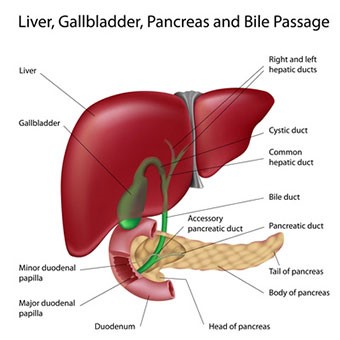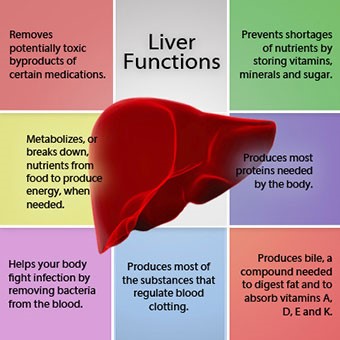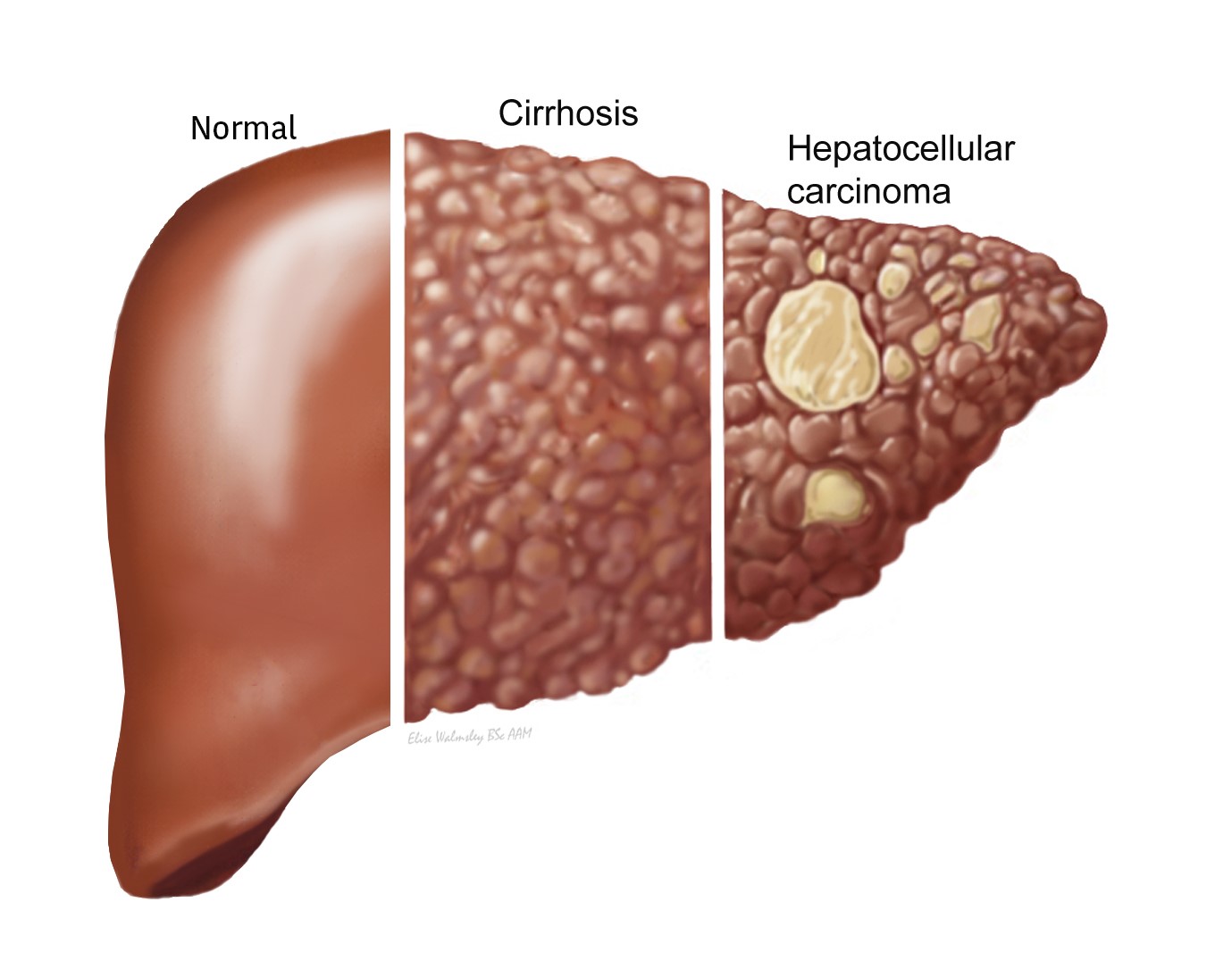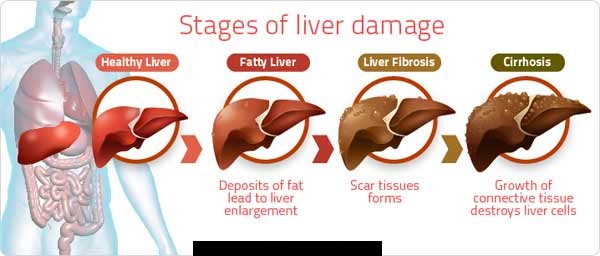Liver cancer
In primary liver cancer, the cancer originates in the liver. (In secondary liver cancer, a cancer spreads to the liver from another part of the body.) Most cases develop as a complication of scarring of the liver (cirrhosis). In general, the outlook is poor. Surgery to remove the cancer is an option in a minority of cases and, if it is possible, gives the best chance of a cure.

Understanding the liver
The liver is in the upper right part of the tummy (abdomen). It has many functions which include:
Storing fuel for the body (called glycogen) which is made from sugars. When required, glycogen is broken down into glucose which is released into the bloodstream.
Helping to process fats and proteins from digested food.
Making proteins that are essential for blood to clot (clotting factors).
Helping to process and/or remove alcohol, many types of medicines, toxins and poisons from the body.
Making bile which passes from the liver to the gut down the bile duct. Bile breaks down the fats in food so that they can be absorbed from the bowel.

Understanding cancer
Cancer is a disease of the cells in the body. The body is made up from millions of tiny cells. There are many different types of cell in the body, and there are many different types of cancer which arise from different types of cell. What all types of cancer have in common is that the cancer cells are abnormal and multiply out of control.
A cancerous (malignant) tumour is a lump or growth of tissue made up from cancer cells which continue to multiply. As they grow, malignant tumours invade into nearby tissues and organs, which can cause damage. Malignant tumours may also spread to other parts of the body. This happens if some cells break off from the first (primary) tumour and are carried in the bloodstream or lymph channels to other parts of the body. These small groups of cells may then multiply to form secondary tumours (metastases) in one or more parts of the body. These secondary tumours may then grow, invade and damage nearby tissues, and spread again.
Some cancers are more serious than others; some are more easily treated than others (particularly if diagnosed at an early stage); some have a better outlook (prognosis) than others.
So, cancer is not just one condition. In each case it is important to know exactly what type of cancer has developed, how large it has become and whether it has spread.
Understanding primary liver cancer
Cancer of the liver can be divided into primary liver cancer and secondary liver cancer:
Primary liver cancer means that the cancer started (originated) in the liver. It occurs most commonly in people aged over 65 years. However, worldwide, it is one of the most common cancers.
Secondary (metastatic) liver cancer means that a cancer which started in another part of the body has spread to the liver. Many types of cancer can spread to the liver. Most commonly, cancers of the bowel pancreas, stomach, lung or breast. The behaviour, treatment and outlook of secondary liver cancers are often quite different to primary liver cancer.
There are different types of primary liver cancer which include:
Hepatocellular carcinoma is the most common type (about 9 in 10 cases). This type of cancer originates from a liver cell (hepatocyte) which becomes cancerous. (The bulk of the liver is made up from hepatocytes).
Hepatocellular carcinoma most commonly develops as a complication of liver diseases such as scarring of the liver (cirrhosis) or types of liver inflammation (hepatitis). Cholangiocarcinoma. This is uncommon. It develops from cells which line the bile duct. Hepatoblastoma. This is a rare cancer which occurs in some young children.
Angiosarcoma. This is rare. It develops from blood vessel cells within the liver.
What causes primary liver cancer?
A cancerous (malignant) tumour starts from one abnormal cell. The exact reason why a cell becomes cancerous is unclear. It is thought that something damages or alters certain genes in the cell. This makes the cell abnormal and multiply out of control.

Most people who develop a primary liver cancer have one or more of the following risk factors which seem to make liver cells more prone to becoming cancerous:
Scarring of the liver (cirrhosis) It tends to progress slowly. The common causes of cirrhosis are heavy alcohol drinking, and infection with hepatitis B & C. However, there are various other causes of cirrhosis.
Note: most people with cirrhosis do not develop liver cancer – it occurs in only a small number of people with cirrhosis.
Long-term infection with the hepatitis B or hepatitis C virus. It typically takes 20-30 years after first becoming infected to develop primary liver cancer. Infection with these viruses is not common but it is becoming more common. However, these are common infections worldwide, particularly in Asia and Africa. Many young children in these areas are infected with the hepatitis B virus. This is why primary liver cancer is a common cancer in young adults in these areas of the world (developing 20-30 years after first being infected).
Ingesting some poisons or toxins. For example, a known risk factor is a poison called aflatoxin which contaminates some foods (for example, mouldy peanuts), mainly in developing countries.
Some conditions which cause persistent inflammation of the gut increase the risk slightly of developing an uncommon type of primary liver cancer (called cholangiocarcinoma) – for example, ulcerative colitis
There is some evidence that smoking can increase the risk.
A parasitic infection (liver fluke) which mainly occurs in Africa and Asia increases the risk of developing a cholangiocarcinoma.

What are the symptoms of primary liver cancer?
There may be no symptoms in the early stage of the disease. As the cancer grows, the first symptoms to develop may be quite vague and nonspecific. For example, feeling generally unwell, feeling sick (nausea), appetite loss, weight loss and tiredness. Many people who develop primary liver cancer will already have symptoms associated with scarring of the liver (cirrhosis). If you already have cirrhosis and your health becomes worse quite quickly, the cause may be a liver cancer which has developed.
As the cancer develops further, more specific symptoms which may also develop include:
Tummy (abdominal) pain over the liver area.
Yellowing (jaundice). You tend to first notice this condition when the whites of your eyes become yellow. It is due to a build-up of the chemical bilirubin which is made in the liver. This occurs if the bile duct becomes blocked by the cancer. Bile and bilirubin cannot drain out from the liver and so leak into the bloodstream.
Itch (caused by the jaundice).
Swelling of the abdomen. This can be due to the growing cancer itself. It may also be due to ascites which is fluid that builds up in the abdomen which occurs with various liver disorders.
How is cancer of the liver diagnosed and assessed
Screening
Screening using ultrasound, and sometimes also a blood test for alpha-fetoprotein (AFP), at 6- to 12-monthly intervals, has been recommended for people at high risk of liver cancer. This includes people with scarring of the liver (cirrhosis) associated with infection with hepatitis B or hepatitis C virus. This can detect liver cancer at an earlier stage and therefore improve the chance of successful treatment.
Initial assessment
If liver cancer is suspected, you are likely to have a number of tests. These aim to:
Confirm that you have a cancer in the liver. Also, that the cancer is a primary liver cancer and not a secondary liver cancer.
Assess the stage of the cancer. That is, how much of the liver is affected and whether the cancer has spread to other parts of the body.
Assess the state of your liver function and your general health.
Therefore, a range of tests is usually needed. Tests may include:
Scans such as ultrasound scan, CT scan or MRI scan.. These can help to show the exact location and extent of the cancer.
A liver biopsy This is usually done to confirm the type of cancer. A biopsy is a procedure in which a small sample of tissue is removed from a part of the body. The sample is then examined under the microscope to look for abnormal cells.
Blood tests help to assess the liver function and your general health.
Other tests may be done if the above do not clarify the situation. For example, a laproscopy is sometimes done.. This is a small operation to look inside the tummy (abdomen) with a flexible telescope.
What are the treatment options for primary liver cancer?
The main treatments used for primary liver cancer are surgery and chemotherapy. Other techniques are sometimes used. The treatment advised in each case depends on various factors such as:
The exact site of the primary tumour in the liver.
How large the cancer is and whether it has spread (the stage of the cancer).
Your general health. In particular, the general state of your liver and liver function. Many people with primary liver cancer also have poor liver function due to scarring of the liver (cirrhosis).
You should have a full discussion with a specialist who knows your case. They will be able to give you the pros and cons, likely success rate, the possible side-effects, and other details about the possible treatment options for your type of cancer.
You should also discuss with your specialist the aims of treatment. For example:
In some cases, treatment aims to cure the cancer. The best chance of a cure for primary liver cancer is when it is diagnosed and treated at an early stage. (Doctors tend to use the word remission rather than the word cured. Remission means there is no evidence of cancer following treatment. If you are in remission, you may be cured. However, in some cases a cancer returns months or years later. This is why doctors are sometimes reluctant to use the word cured.)
In some cases, treatment aims to control the cancer. If a cure is not realistic, with treatment it may be possible to limit the growth or spread of the cancer so that it progresses less rapidly. This may keep you free of symptoms for some time.
In some cases, treatment aims to ease symptoms (palliative treatment). For example, if a cancer is advanced then you may require painkillers or other treatments to help keep you free of pain or other symptoms. Some treatments may be used to reduce the size of a cancer, which may ease symptoms such as pain.
Surgery
Surgery which aims to cure the cancer is an option in some cases. If the cancer is small, has not spread outside the liver and the rest of the liver is healthy, it may be possible to cut out the part of the liver which contains the cancer. Healthy liver tissue will regrow to its full size within a few weeks if a section of liver is cut out. However, this operation is not suitable if your liver is damaged with severe cirrhosis (which is the case in many people with primary liver cancer).
A liver transplant is another option but again only suitable for a small number of cases.
Surgery also has a role in palliative care. For example, if yellowing (jaundice) is severe, it may be possible to relieve the blockage of the bile by inserting a stent. This is a narrow tube which allows the bile to drain into the gut. Another example is to ease fluid in the tummy (abdomen) – called ascites – if it is severe. The ascites can be drained by inserting a tube through the wall of the abdomen.
Chemotherapy
Chemotherapy is a treatment which uses anti-cancer medicines to kill cancer cells, or to stop them from multiplying. It is not likely to be curative for primary liver cancer but may shrink the tumour down to slow the progression of the disease.
There are new medicines being developed for the treatment of liver cancer. For example, sorafenib is a type of medicine called a multi-targeted kinase inhibitor. It interferes with the growth of cancer cells. Research has shown that sorafenib can be beneficial for people with advanced hepatocellular carcinoma. However, sorafenib is not currently recommended for the treatment of people with advanced hepatocellular carcinoma.
Other treatments
Various other treatment techniques are sometimes used – for example:
Alcohol ablation. Ablation means to destroy. For this treatment, alcohol is injected into the tumour. The alcohol kills cancer cells.
Radiofrequency ablation. For this treatment, a needle is inserted into the tumour. High-intensity radio waves or laser light are then passed through the needle. This heats the cancer cells and kills them. Cryotherapy. For this treatment, a small metal object filled with liquid nitrogen is placed into the tumour. The liquid nitrogen makes it very cold which destroys cancer cells.
Chemoembolisation. For this treatment, medicines used for chemotherapy are mixed with another oily chemical. The mixture is then injected into branches of the liver artery (hepatic artery) which are supplying the tumour with blood. The oily chemical helps to hold the chemotherapy medicines longer in the liver and make them more effective in killing cancer cells.
Radiotherapy-a treatment which uses high-energy beams of radiation which are focused on cancerous tissue. This kills cancer cells, or stops cancer cells from multiplying. Radiotherapy is not often used for primary liver cancers apart from the uncommon cholangio carcinoma type of cancer.
What is the outlook (prognosis)?
Overall, the outlook is poor. Many people who develop primary liver cancer are already in poor health with scarring of the liver (cirrhosis). The best chance of a cure is with surgery when the cancer is small, has not spread from the liver and the rest of your liver is relatively healthy. However, this situation only occurs in a minority of cases. The various other treatments described above may delay the progression of the disease but are not often curative.